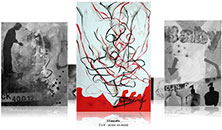I'm really saying that: as a fine artist in this day and age I struggle to budget time between hours on the canvas (or wood panel in my case) and learning SEO tactics or the latest Photoshop tutorial that can help me add a slight professional edge to my web design marketing plan.
The following is a very small example to help illustrate my point. I wanted to add a blog button to my fine art website kickthefaucet.com ... but I wanted it to be consistent with the theme of the site. Besides the fact that most of the site is in Flash (I'll save the flash knowledge argument for another post entirely) and its loaded thru FTP by Dreamweaver and graphics are edited highly in Photoshop - damn, I should by stock in ADBE; side note if you bought 100 shares of Adobe in the mid 1980(s) you would probably be a millionaire now... anyway, what was I talking about... oh yeah, Photoshop, so I had to make something (quick and fun) to support the OCD, obsessive compulsive theme consistent across the website. A bar of soap will do!! But the typical bar of soap that sits in my bathroom closet does not say blog on it -- hence, where Photoshop comes in:
- I took a quick snapshot of a fresh, new bar (ahhhh... the fresh sent - oh baby!!) of soap with a 2 mega-pixel phone camera:
- Notice the bar says Dial... ehh not really interested in advertising for them (yet) so that had to change, but with a similar font:
- After using the "Dial" as a place holder/guide, it had to go. Thanks Mr. Clone-Tool:
- Finally, I had to make the new type "blog" look like the Dial original type and also the ANTIBACTERIAL sub tag line. So with the help of some layer transparency styles in Photoshop (I didn't need to get too technical as I new the final .jpeg would be small) I got the highlight and color close enough:
- And below is the final with the gray background to match the background of the website. This is to avoid using a .png24 with alpha channel support; which leads to higher than necessary file size in this case:





So, essentially, if I were to pay a web designer to help me look professional when represented globally on the internet, then I wouldn't need to know Photoshop. But I do know Photoshop, and the money I save on not paying a web designer... maybe I'll invest in ADBE and retire rich - as I believe that many categories of artists, even fine artists, will be buying, learning and using these programs for decades to come.


